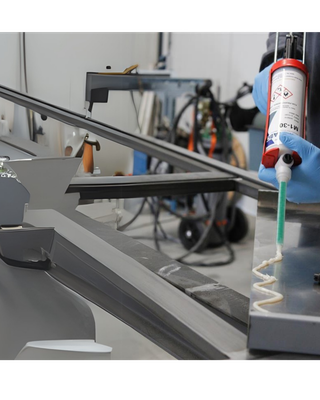
- Home
- Knowledge Hub
- Structural Adhesives
- Applying structural adhesives
Applying structural adhesives
Although some adhesives are single component and can cure by other mechanisms such as heat or UV, Scott Bader’s Crestabond and Crestomer structural adhesives are two-component and cure by a process of polymerisation. Two-part adhesives need to be fully mixed at the point of application, the two components can be kept separate until that point.
Ratios vary from 50:1 (Crestafix), 10:1 (Crestomer and Crestabond M1), and 1:1 (Crestomer Advantage and Crestabond M7). If the ratio is narrow (1:1 to 10:1) the two need to have similar viscosities, wide ratio usually has different viscosities and a specially designed static mixer. Larger quantities can be pumped using a machine.
Surface preparation
Surface prep is a crucial step in achieving a high strength, high quality bond.
The type and degree of surface preparation depends on the nature of the surface and the adhesive. The surface of the materials to be bonded can be treated/prepared to make them more susceptible to bonding, particularly if it has low surface energy. This may be etching, abrading or simply cleaning with a suitable solvent to remove any dust, grease or oil on the surface.
The surface needs to be:

Bond design
It is important to understand the forces acting upon the joint and the direction of loads because adhesives work best in compression and shear, less so in tension and very poorly in peel.
Avoiding stress raisers and peeling forces will enable a strong bond, as will protecting the joint from heat and chemical exposure.
Other considerations besides direct loads include the fatigue resistance and sound and vibration absorption of the parts.
Working with structural adhesives
To work, an adhesive needs to be applied to a substrate with a prepared surface.
There are many ways to apply adhesives, such as:
From a cartridge
Machine metering
Spatula or trowel
Brushing
Spraying
Hot melt
The first three are most often used with Scott Bader’s structural adhesives.
Failure modes
Again, it is important to understand how the forces acting upon the joint can break it, and design accordingly.
Cohesive failure, substrate delamination and failure modes are all predictable. Strengths, moduli, and elongation are known quantities that can be factored into the overall design so that stress limits are not reached.
Tips
Good surface prep can prevent adhesion failure
Avoid designs that expose bond lines to peeling forces
Creep and yield can be avoided by protecting the bond line from excessive heat beyond margins of safety
For bulk application, the adhesive and activator components will be supplied separately and will need to be either mixed by hand, or by the use of dedicated dispensing equipment.
Be sure to take note of the recommended mix ratio (by weight or by volume) of the product, displayed on the TDS. Only by adhering to this mixing ratio will you fulfil the stated properties of the product. If unsure, please contact our Technical Support team for advice.
How structural adhesives are revolutionising solar PV instalation
Learn more from our solar installation expert
How structural adhesives are revolutionising solar PV installationRelated

Storing and handling adhesives
Storage and handling recommendations for Scott Bader’s adhesives range.
!["Application of Scott Bader gelcoats on a smooth composite surface, showcasing the finishing process for marine materials" [G]](https://a.storyblok.com/f/329344/8333x2083/d5276172ea/crestabond-application-header.jpg/m/320x400)
How does a structural adhesive work?
A structural adhesive not only bonds substrates to one another, but a structure made from two or more parts bonded together gains structural strength from an adhesive.
Your guide to MMA structural adhesives
Scott Bader’s range of Crestabond MMA primerless structural adhesives are specifically designed to bond various substrates with minimal preparation needed and no requirement for primer, dramatically...
!["Construction workers installing solar panels on a flat roof, using Scott Bader structural adhesives for secure mounting" [G]](https://a.storyblok.com/f/329344/4032x2268/c647cb7022/solar-installation-with-crestabond-2.jpg/m/320x400)
How structural adhesives are revolutionising solar PV installation
We recently caught up with Scott Bader’s solar PV expert, Andrew Harvey, on the improvements structural adhesives bring to solar installation, and how they should be used for optimum installation.
